Rif A. Saurous
Shammie
MesaNet: Sequence Modeling by Locally Optimal Test-Time Training
Jun 05, 2025Abstract:Sequence modeling is currently dominated by causal transformer architectures that use softmax self-attention. Although widely adopted, transformers require scaling memory and compute linearly during inference. A recent stream of work linearized the softmax operation, resulting in powerful recurrent neural network (RNN) models with constant memory and compute costs such as DeltaNet, Mamba or xLSTM. These models can be unified by noting that their recurrent layer dynamics can all be derived from an in-context regression objective, approximately optimized through an online learning rule. Here, we join this line of work and introduce a numerically stable, chunkwise parallelizable version of the recently proposed Mesa layer (von Oswald et al., 2024), and study it in language modeling at the billion-parameter scale. This layer again stems from an in-context loss, but which is now minimized to optimality at every time point using a fast conjugate gradient solver. Through an extensive suite of experiments, we show that optimal test-time training enables reaching lower language modeling perplexity and higher downstream benchmark performance than previous RNNs, especially on tasks requiring long context understanding. This performance gain comes at the cost of additional flops spent during inference time. Our results are therefore intriguingly related to recent trends of increasing test-time compute to improve performance -- here by spending compute to solve sequential optimization problems within the neural network itself.
All Random Features Representations are Equivalent
Jun 27, 2024Abstract:Random features are an important technique that make it possible to rewrite positive-definite kernels as infinite-dimensional dot products. Over time, increasingly elaborate random feature representations have been developed in pursuit of finite approximations with ever lower error. We resolve this arms race by deriving an optimal sampling policy, and show that under this policy all random features representations have the same approximation error. This establishes a lower bound that holds across all random feature representations, and shows that we are free to choose whatever representation we please, provided we sample optimally.
Scalable Spatiotemporal Prediction with Bayesian Neural Fields
Mar 12, 2024Abstract:Spatiotemporal datasets, which consist of spatially-referenced time series, are ubiquitous in many scientific and business-intelligence applications, such as air pollution monitoring, disease tracking, and cloud-demand forecasting. As modern datasets continue to increase in size and complexity, there is a growing need for new statistical methods that are flexible enough to capture complex spatiotemporal dynamics and scalable enough to handle large prediction problems. This work presents the Bayesian Neural Field (BayesNF), a domain-general statistical model for inferring rich probability distributions over a spatiotemporal domain, which can be used for data-analysis tasks including forecasting, interpolation, and variography. BayesNF integrates a novel deep neural network architecture for high-capacity function estimation with hierarchical Bayesian inference for robust uncertainty quantification. By defining the prior through a sequence of smooth differentiable transforms, posterior inference is conducted on large-scale data using variationally learned surrogates trained via stochastic gradient descent. We evaluate BayesNF against prominent statistical and machine-learning baselines, showing considerable improvements on diverse prediction problems from climate and public health datasets that contain tens to hundreds of thousands of measurements. The paper is accompanied with an open-source software package (https://github.com/google/bayesnf) that is easy-to-use and compatible with modern GPU and TPU accelerators on the JAX machine learning platform.
Robust Inverse Graphics via Probabilistic Inference
Feb 02, 2024Abstract:How do we infer a 3D scene from a single image in the presence of corruptions like rain, snow or fog? Straightforward domain randomization relies on knowing the family of corruptions ahead of time. Here, we propose a Bayesian approach-dubbed robust inverse graphics (RIG)-that relies on a strong scene prior and an uninformative uniform corruption prior, making it applicable to a wide range of corruptions. Given a single image, RIG performs posterior inference jointly over the scene and the corruption. We demonstrate this idea by training a neural radiance field (NeRF) scene prior and using a secondary NeRF to represent the corruptions over which we place an uninformative prior. RIG, trained only on clean data, outperforms depth estimators and alternative NeRF approaches that perform point estimation instead of full inference. The results hold for a number of scene prior architectures based on normalizing flows and diffusion models. For the latter, we develop reconstruction-guidance with auxiliary latents (ReGAL)-a diffusion conditioning algorithm that is applicable in the presence of auxiliary latent variables such as the corruption. RIG demonstrates how scene priors can be used beyond generation tasks.
Training Chain-of-Thought via Latent-Variable Inference
Nov 28, 2023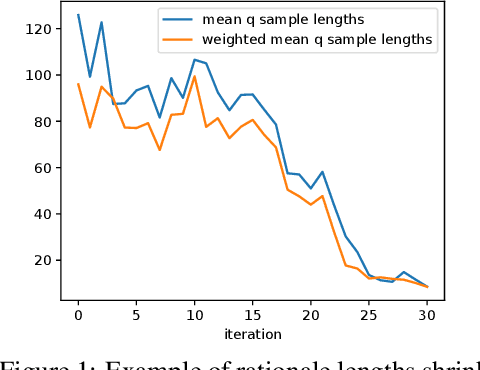


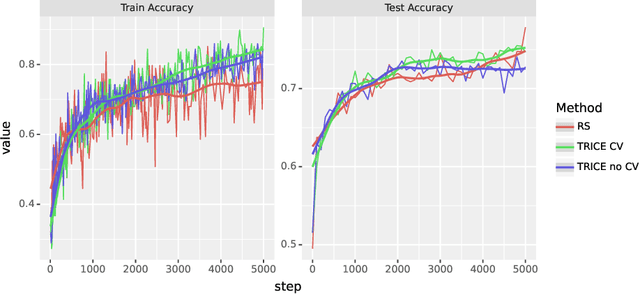
Abstract:Large language models (LLMs) solve problems more accurately and interpretably when instructed to work out the answer step by step using a ``chain-of-thought'' (CoT) prompt. One can also improve LLMs' performance on a specific task by supervised fine-tuning, i.e., by using gradient ascent on some tunable parameters to maximize the average log-likelihood of correct answers from a labeled training set. Naively combining CoT with supervised tuning requires supervision not just of the correct answers, but also of detailed rationales that lead to those answers; these rationales are expensive to produce by hand. Instead, we propose a fine-tuning strategy that tries to maximize the \emph{marginal} log-likelihood of generating a correct answer using CoT prompting, approximately averaging over all possible rationales. The core challenge is sampling from the posterior over rationales conditioned on the correct answer; we address it using a simple Markov-chain Monte Carlo (MCMC) expectation-maximization (EM) algorithm inspired by the self-taught reasoner (STaR), memoized wake-sleep, Markovian score climbing, and persistent contrastive divergence. This algorithm also admits a novel control-variate technique that drives the variance of our gradient estimates to zero as the model improves. Applying our technique to GSM8K and the tasks in BIG-Bench Hard, we find that this MCMC-EM fine-tuning technique typically improves the model's accuracy on held-out examples more than STaR or prompt-tuning with or without CoT.
Sequential Monte Carlo Learning for Time Series Structure Discovery
Jul 13, 2023Abstract:This paper presents a new approach to automatically discovering accurate models of complex time series data. Working within a Bayesian nonparametric prior over a symbolic space of Gaussian process time series models, we present a novel structure learning algorithm that integrates sequential Monte Carlo (SMC) and involutive MCMC for highly effective posterior inference. Our method can be used both in "online" settings, where new data is incorporated sequentially in time, and in "offline" settings, by using nested subsets of historical data to anneal the posterior. Empirical measurements on real-world time series show that our method can deliver 10x--100x runtime speedups over previous MCMC and greedy-search structure learning algorithms targeting the same model family. We use our method to perform the first large-scale evaluation of Gaussian process time series structure learning on a prominent benchmark of 1,428 econometric datasets. The results show that our method discovers sensible models that deliver more accurate point forecasts and interval forecasts over multiple horizons as compared to widely used statistical and neural baselines that struggle on this challenging data.
* 17 pages, 8 figures, 2 tables. Appearing in ICML 2023
Grammar Prompting for Domain-Specific Language Generation with Large Language Models
May 31, 2023



Abstract:Large language models (LLMs) can learn to perform a wide range of natural language tasks from just a handful of in-context examples. However, for generating strings from highly structured languages (e.g., semantic parsing to complex domain-specific languages), it is challenging for the LLM to generalize from just a few exemplars. We explore $\textbf{grammar prompting}$ as a simple approach for enabling LLMs to use external knowledge and domain-specific constraints, expressed through a grammar expressed in Backus--Naur Form (BNF), during in-context learning. Grammar prompting augments each demonstration example with a specialized grammar that is minimally sufficient for generating the particular output example, where the specialized grammar is a subset of the full DSL grammar. For inference, the LLM first predicts a BNF grammar given a test input, and then generates the output according to the rules of the grammar. Experiments demonstrate that grammar prompting can enable LLMs to perform competitively on a diverse set of DSL generation tasks, including semantic parsing (SMCalFlow, Overnight, GeoQuery), PDDL planning, and even molecule generation (SMILES).
ProbNeRF: Uncertainty-Aware Inference of 3D Shapes from 2D Images
Oct 27, 2022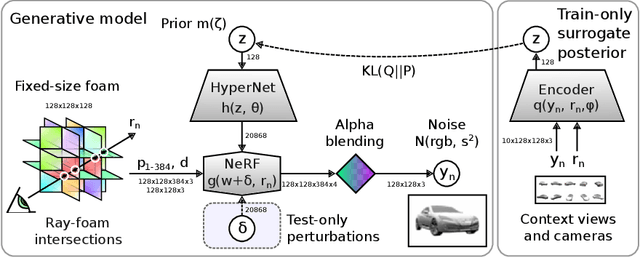

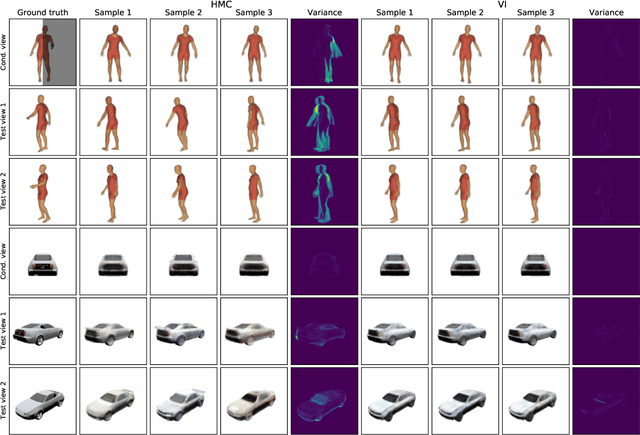
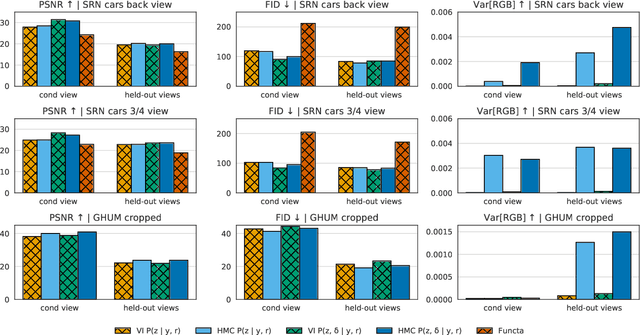
Abstract:The problem of inferring object shape from a single 2D image is underconstrained. Prior knowledge about what objects are plausible can help, but even given such prior knowledge there may still be uncertainty about the shapes of occluded parts of objects. Recently, conditional neural radiance field (NeRF) models have been developed that can learn to infer good point estimates of 3D models from single 2D images. The problem of inferring uncertainty estimates for these models has received less attention. In this work, we propose probabilistic NeRF (ProbNeRF), a model and inference strategy for learning probabilistic generative models of 3D objects' shapes and appearances, and for doing posterior inference to recover those properties from 2D images. ProbNeRF is trained as a variational autoencoder, but at test time we use Hamiltonian Monte Carlo (HMC) for inference. Given one or a few 2D images of an object (which may be partially occluded), ProbNeRF is able not only to accurately model the parts it sees, but also to propose realistic and diverse hypotheses about the parts it does not see. We show that key to the success of ProbNeRF are (i) a deterministic rendering scheme, (ii) an annealed-HMC strategy, (iii) a hypernetwork-based decoder architecture, and (iv) doing inference over a full set of NeRF weights, rather than just a low-dimensional code.
Language Model Cascades
Jul 28, 2022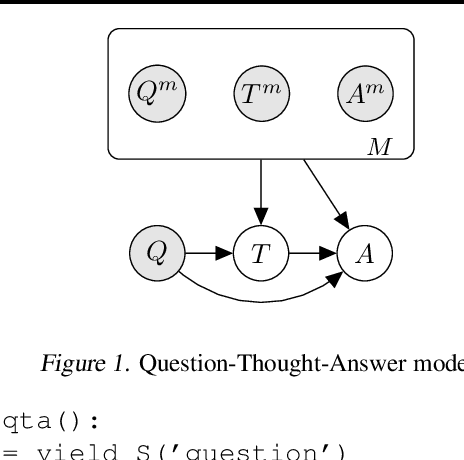
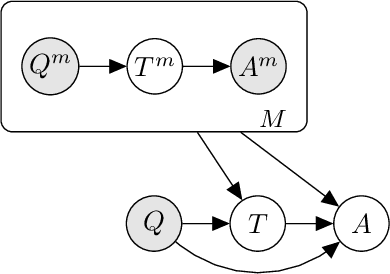
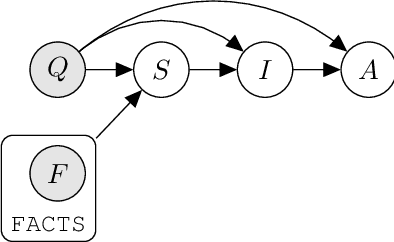
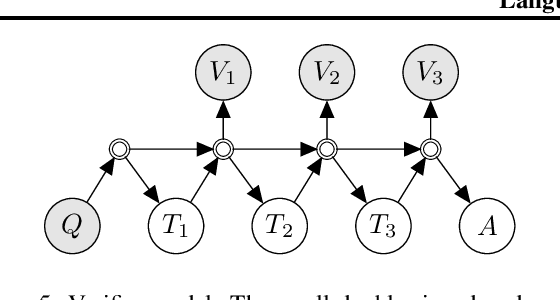
Abstract:Prompted models have demonstrated impressive few-shot learning abilities. Repeated interactions at test-time with a single model, or the composition of multiple models together, further expands capabilities. These compositions are probabilistic models, and may be expressed in the language of graphical models with random variables whose values are complex data types such as strings. Cases with control flow and dynamic structure require techniques from probabilistic programming, which allow implementing disparate model structures and inference strategies in a unified language. We formalize several existing techniques from this perspective, including scratchpads / chain of thought, verifiers, STaR, selection-inference, and tool use. We refer to the resulting programs as language model cascades.
Beyond the Imitation Game: Quantifying and extrapolating the capabilities of language models
Jun 10, 2022Abstract:Language models demonstrate both quantitative improvement and new qualitative capabilities with increasing scale. Despite their potentially transformative impact, these new capabilities are as yet poorly characterized. In order to inform future research, prepare for disruptive new model capabilities, and ameliorate socially harmful effects, it is vital that we understand the present and near-future capabilities and limitations of language models. To address this challenge, we introduce the Beyond the Imitation Game benchmark (BIG-bench). BIG-bench currently consists of 204 tasks, contributed by 442 authors across 132 institutions. Task topics are diverse, drawing problems from linguistics, childhood development, math, common-sense reasoning, biology, physics, social bias, software development, and beyond. BIG-bench focuses on tasks that are believed to be beyond the capabilities of current language models. We evaluate the behavior of OpenAI's GPT models, Google-internal dense transformer architectures, and Switch-style sparse transformers on BIG-bench, across model sizes spanning millions to hundreds of billions of parameters. In addition, a team of human expert raters performed all tasks in order to provide a strong baseline. Findings include: model performance and calibration both improve with scale, but are poor in absolute terms (and when compared with rater performance); performance is remarkably similar across model classes, though with benefits from sparsity; tasks that improve gradually and predictably commonly involve a large knowledge or memorization component, whereas tasks that exhibit "breakthrough" behavior at a critical scale often involve multiple steps or components, or brittle metrics; social bias typically increases with scale in settings with ambiguous context, but this can be improved with prompting.
 Add to Chrome
Add to Chrome Add to Firefox
Add to Firefox Add to Edge
Add to Edge